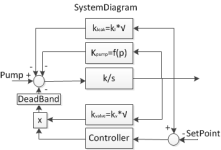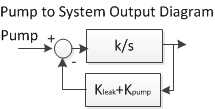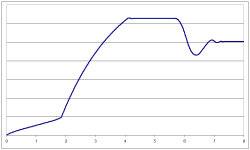The 125psi target might (will!) change in the future, I'd like to design the system to respond better to any future setpoints that might be implemented.
Below you can see a diagram of your system
kleak - system leakage coefficient (~sqrt(system pressure))
kpump - pump efficiency reduction factor
kvalve - coefficient of increase in the capacity of the control valve (~sqrt(system pressure))
You can define controller gains using system transfer function
G(s) = (k/s)*exp(-deadtime*s) / (1 + k/s*exp(-deadtime*s) * (kleak + kpump + kvalve * (kp + ki/s)))
I also gave a diagram from the Pump to the system output. Transfer function from the Pump to the system output is:
G(s) = k / (T*s+1)
T = 1 / (k*(kleak + kpump)
k = 1 / (kleak + kpump)
If we express the deadband as deadtime, then the transfer function from the controller output to the system output is:
G(s) = k * exp(-DeadTime*s) / (T*s+1)
T = 1 / (k*(kleak + kpump)
k = kvalve / (kleak + kpump)
The more pressure, the more kleak, kpump, kvalve, i.e. decreases T (for both TFs), the gain from the pump to the system outlet decreases more than CO to SO gain. That is why the control is more effective at high pressure.
If we find CO to SO transfer function coefficients (using the curves from your post #41):
G(s) = 0.91 * exp(-60*s) / (36*s+1)
60/36 = 1,6667 – it is NOT good
In other words your ACTUAL PROBLEM IS A CONTROL VALVE DEADBAND
The most efficient solution would be make control valve position=24% (or what the actual deadband) to controller output=0 as drbitboy wrote.
This case you'll get easiest to control first order lag plant
G(s) = 0.91/ (36*s+1)
I think it would be safer to set the control valve position to 0 at the end of the cycle.











